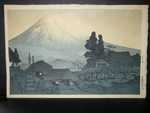| | |
| Artist: | Shotei Takahashi (1871-1945) Hiroaki — 松亭高橋、弘明 |
| Title: | Fuji From Mizukubo, Evening Scene |
| Series: | |
| Date of first edition?: | 1936 (circa) |
| Date of this artwork?: | 1930s (may not be accurate) |
| Publisher (first edition)?: | Watanabe — 渡辺 |
| Publisher (this edition)?: | Watanabe — 渡辺 |
| Medium (first edition): | Woodblock |
| Medium (this edition): | Woodblock |
| Format (first edition): | Oban
|
| Format (this edition): | Oban |
| DB artwork code: | 31016 |
| Notes (first edition)?: |
|
| Notes (this edition)?: |
| The following information was taken from the original web listing of this artwork. Note that there may be some inaccuracies:
A Japanese woodblock print by Takahashi Shotei (1871-1945) also known as Takahashi Hiroaki. This print is Mt. Fuji from near Tamaho, published by Watanabe, C. 1936, 15 3/4 " x 10 1/4" . At the top of the print, on the back side, there is tape at the top edge (this was matted and framed when new and removed from the frame about 50 years ago and placed in a folder with other prints). Great bleed thru and a rare print !!
|
|
| Artist Bio: |
Takahashi Shotei was born in Tokyo with the given name of Takahashi Katsutaro. At a young age he was trained in Nihon-ga , the traditional Japanese painting style by his uncle Matsumoto Fuko, and beginning around 1907 Shotei started designing for the Watanabe Color Print Company. Shotei was among the first designers to be recruited into Watanabe's stable of artists, which would later expand to include Goyo, Shinsui, Hasui, Kasamatsu, Koson and Koitsu among others. Many Watanabe prints were designed for export, primarily to North America, where the demand for all things Japanese was high in the early 20th century.
By 1923 Shotei had produced nearly 500 designs for Watanabe, when Tokyo was hit by the Great Kanto earthquake -- the worst recorded natural catastrophe in the history of Japan. The fires ignited by the earthquake raged for three days, and Watanabe's print shop and all the woodblocks created by Shotei and the other early shin hanga artists, were destroyed.
After the earthquake Shotei created another 250 prints mostly depicting scenic Japanese landscapes in the shin hanga style he had helped to define. He continued to work for Watanabe, but also worked with the publishers Fusui Gabo and Shobido Tanaka, where he had more control over the finished print than was possible with Watanabe.
Shotei used a variety of names, signatures and seals during his lifetime. From 1907 until 1922 he used the name Shotei, and after 1922 Hiroaki and Komei.
|
|











